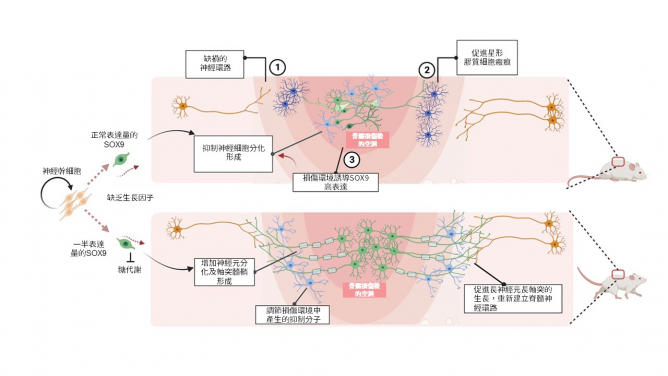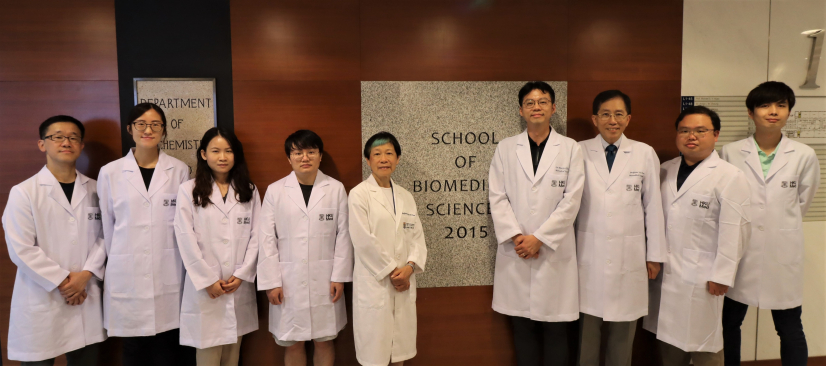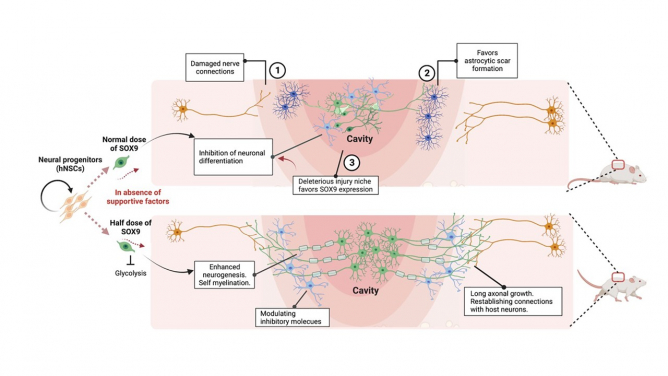Media
HKUMed & CityU researchers jointly generate human neural stem cells with powerful therapeutic potential for the treatment of spinal cord injury, paving the way for new therapeutic opportunities
16 Aug 2023

Spinal cord injury (SCI) causes nerve damage and the injury environment favours SOX9 expression; grafting of hNSCs with a half dose of SOX9 acquires unique intrinsic capacity resulting in enhanced neurogenesis, long axonal growth, and establishing neuronal connectivity with the host that restores walking capacity and temperature sensation of the SCI animals.

A research team from HKUMed has generated human neural stem cells with powerful therapeutic potential for the treatment of spinal cord injury that paves the way for new therapeutic opportunities. The research team members include: (from left) Wu Ming-hoi, Hui Man-ning, Feng Xianglan, Chen Yong-long, Professor Daisy Shum Kwok-yan, Dr Martin Cheung Chi-hang, Professor Chan Ying-shing, Dr Tam Kin-wai and Amos Lo Lok-hang.

Spinal cord injury (SCI) causes nerve damage and the injury environment favours SOX9 expression; grafting of hNSCs with a half dose of SOX9 acquires unique intrinsic capacity resulting in enhanced neurogenesis, long axonal growth, and establishing neuronal connectivity with the host that restores walking capacity and temperature sensation of the SCI animals.

Spinal cord injury (SCI) causes nerve damage and the injury environment favours SOX9 expression; grafting of hNSCs with a half dose of SOX9 acquires unique intrinsic capacity resulting in enhanced neurogenesis, long axonal growth, and establishing neuronal connectivity with the host that restores walking capacity and temperature sensation of the SCI animals.

A research team from HKUMed has generated human neural stem cells with powerful therapeutic potential for the treatment of spinal cord injury that paves the way for new therapeutic opportunities. The research team members include: (from left) Wu Ming-hoi, Hui Man-ning, Feng Xianglan, Chen Yong-long, Professor Daisy Shum Kwok-yan, Dr Martin Cheung Chi-hang, Professor Chan Ying-shing, Dr Tam Kin-wai and Amos Lo Lok-hang.
- 1 / 3
- 2 / 3
- 3 / 3
A joint research team from LKS Faculty of Medicine, the University of Hong Kong (HKUMed) and City University of Hong Kong (CityU) has generated human neural stem cells with powerful therapeutic potential for the treatment of spinal cord injury that paves the way for new therapeutic opportunities. The new findings are now published in the leading multidisciplinary science journal, Advanced Science [link to publication].
Background
Traumatic spinal cord injury (SCI) commonly caused by a car accident, fall, or sport-related accident results in the progressive loss of neurons involved in motor and sensory functions at and around the site of injury. Consequently, SCI patients suffer from either permanent paralysis or varying degrees of impairment and loss of sensation depending on the severity of the injury. Currently, there are no effective treatments for SCI. The limited locomotor and sensory recovery after SCI has been attributed to the formation of glial scar around the site of injury that form the barrier-like structure to prevent neuronal regeneration. In addition, spinal neurons around the scar cannot be restored due to the low intrinsic regenerative ability of undamaged neurons and the lack of neural stem cells (NSCs) in the adult spinal cord.
Transplantation of human NSCs (hNSCs) derived from human pluripotent stem cells at the SCI sites has been considered a promising therapeutic strategy to compensate for the loss of spinal neurons and enable their connectivity with host neurons for spinal cord recovery. However, the injury environment favours astrocytes instead of neuronal formation which has limited the therapeutic efficacy of grafted hNSCs. Hence, most transplantation therapies adopt the use of a cocktail of growth factors embedded in the extracellular matrix to enhance the viability and neurogenic potency of grafted hNSCs in SCI rodent models, yet this approach takes a long time for hNSCs to mature and support functional recovery. This underlies an urgent need to remodel NSC grafts that can overcome both extrinsic and intrinsic barriers as an effective treatment for traumatic SCI.
Research methods and findings
The research team found that the graded reduction of Sex determining region Y-box transcription factor SOX9 gene expression in hNSCs is highly associated with the acquisition of neuronal lineage toward motor neuron fate. Consistently, the reduction of SOX9 expression by approximately 50% in hNSCs promotes motor neuron formation. Further reduction of SOX9 expression levels results in compromised cell survival and renewal. These findings indicate a dose-dependent role of SOX9 in regulating the initiation of neuronal formation, self-renewal, and survival of hNSCs. The enhanced neurogenic potency of hNSCs expressing 50% of SOX9 protein is partly attributed to decreased glucose consumption. These neurogenic and metabolic properties are retained in the SOX9-reduced hNSCs upon transplantation at the site of contusive SCI in rats without the need for growth-factor enriched matrics, suggesting that the injury environment did not affect their metabolic state and neuronal differentiation potential.
Importantly, SOX9 KD grafts exhibit excellent integration properties, predominantly differentiate into motor neurons, reduce glial scar matrix accumulation to facilitate long-distance axon growth and neuronal connectivity with the host as well as dramatically improve walking capacity and temperature sensation in recipient animals. Altogether, the research findings demonstrate that hNSCs with reduced SOX9 expression by half could overcome the post-injury environment and intrinsic limitations with enhanced therapeutic potential in the SCI rodent model. To enable the clinical translational of our findings, future efforts should focus on developing genetic strategies to reduce the level of SOX9 activity or expression in hNSCs by ~ 50% for transplantation treatment of SCI patients.
Significance of the study
‘Our work reveals a new paradigm in activating the intrinsic programme by using a genetically targeted strategy to enhance the therapeutic potential of hNSCs for treating SCI. This approach alters the grafts’ response in the injury environment and confers enhanced neuronal differentiation capacity, survival, and integration, as well as reduced glial scar formation to provide a more effective stem cell therapy for severe traumatic SCI,’ said Dr Martin Cheung Chi-hang, Associate Professor, School of Biomedical Sciences, HKUMed, also the lead researcher of the study.
About the research team
The research was led by Dr Martin Cheung Chi-hang, Associate Professor of the School of Biomedical Sciences, HKUMed; Dr Jessica Liu Aijia, Assistant Professor in the Department of Neuroscience, CityU; Professor Chan Ying-shing, Dexter H C Man Family Professor in Medical Science, Professor of the School of Biomedical Sciences, Director of Campus Development and Infrastructure, HKUMed, and Director of the Neuroscience Research Centre, HKU. Other members of the research team include Dr Tam Kin-wai, Chen Yong-long, Feng Xianglan, Christy Chan Wing-lam, Amos Lo Lok-hang, Dr Kenneth Wu Lap-kei, Hui Man-ning, Wu Ming-hoi, Dr Ken Chan Kwok-keung, and May Cheung Pui-lai. Other collaborators include Professor Cheung Chi-wai from the Department of Anaesthesiology, School of Clinical Medicine, HKUMed and Professor Daisy Shum Kwok-yan from School of Biomedical Sciences, HKUMed.
Acknowledgements
The work was supported by the General Research Fund of the Hong Kong Research Grants Council (No. 17123016, and No. 17110715).
Media enquiries
Please contact LKS Faculty of Medicine of The University of Hong Kong by email (medmedia@hku.hk).
